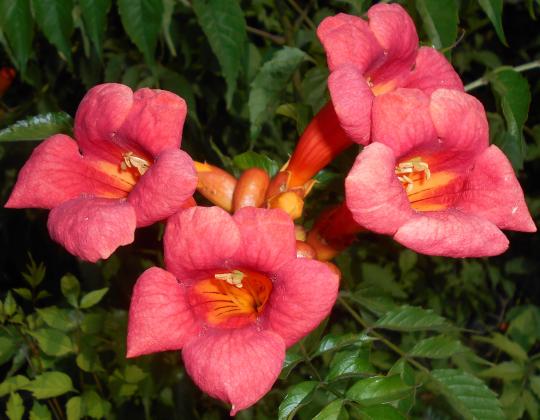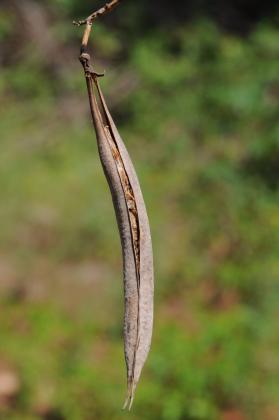Campsis radicans - Bodyguards are rewarded with special nectar for attacking herbivores
Campsis radicans, trumpet vine or trumpet creeper, is a perennial Texas native. It is a deciduous woody vine that can get 40 feet high and 10 feet wide using aerial roots. Its opposite leaves have 9 to 11 leaflets with sawed edges. It climbs by wrapping its stem around a support. If a stem touches the ground it will root. The vine is strong enough to bring down some structures. In Latin Campsis means "to curve". Radicans means "stems with roots".
The plant also spreads from underground roots whose shoots may travel underground for several yards before they pop up above ground away from the original plant. The ability to travel underground is why a hard winter that kills above ground parts will not kill the plant. Nor will cutting the plant to the ground. A vine segment as small as ½ inch can form roots and grow into its own vine. Trumpet vine has few diseases or pest problems and can become invasive if you let it get out of hand.
Red-orange, sometimes yellow, trumpet-shaped flowers, about 3 inches long, grow in clusters at the end of branches during spring and summer. They may stay on the plant after they have been fertilized. It's thought that the large floral display attracts pollinators until most of the flowers have been pollinated. As flowers fade, bean-shaped 2 to 6 inch long seedpods turn brown and split down the middle exposing hundreds of flat, winged seeds.
The plant is toxic to most mammals so they leave it alone. Some people get contact dermatitis from handling trumpet vine although it’s not as bad as poison ivy.
A nectary is a glandular organ that holds nectar. It’s usually inside the flower, past the pollen. Trumpet vine is mostly pollinated by hummingbirds that stick their long tongue into the flower to get to the nectary at the bottom. But some insects and small animals “cheat” by crawling up the stem to chomp down on the flower's base from the outside. They eat the nectar without contributing to pollination. Trumpet vine also faces dangers from herbivores that eat its fruit needed for reproduction and its leaves needed for photosynthesis, a process that turns sunlight into chemical energy.
To protect its vital structures, trumpet vine uses insect "body guards", predatory insects, mainly ants, to attack the herbivores. Guards are rewarded with nectar from outside the flower, extrafloral nectaries. These additional nectaries are located on its petiole, calyx, corolla and seedpod. They secrete a different type of nectar than is found inside the flower. Guards can be seen crawling on the plant guarding their nectar sources.
The National Institutes of Health, ncbi.nlm.nih.gov, has a trumpet vine extrafloral nectary article, "Nectar: its production and functions in trumpet creeper".
Autumn is the time to harvest and plant trumpet vine seeds for spring seedlings. Texas A&M University has several articles about the plant at aggie-horticulture.tamu.edu.
Deborah Richardson is a freelance reporter for The Examiner with a fondness for flora in its natural setting.



